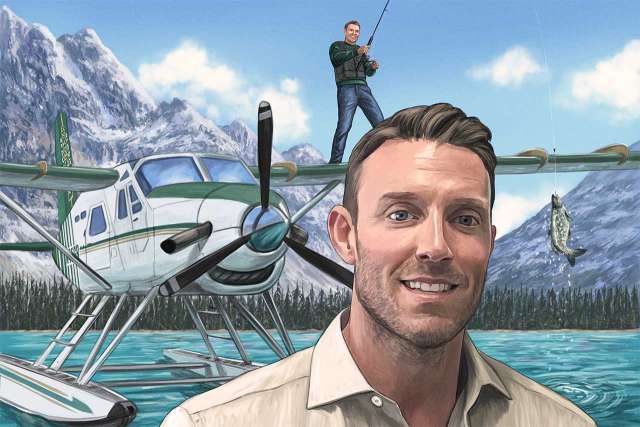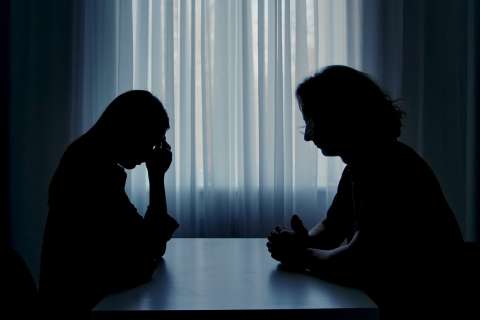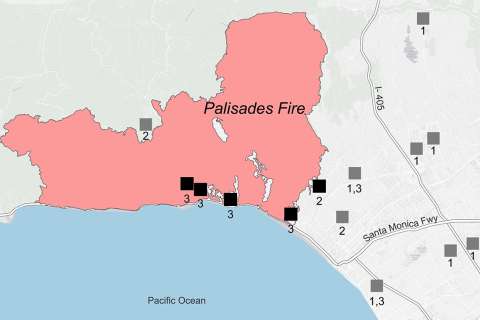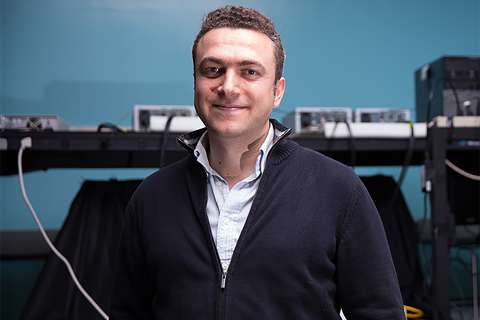Dr. David A. Nathanson
Steps into the U Magazine Spotlight
As a kid growing up in Alaska, David A. Nathanson, PhD ’11 (FEL ’13), aspired to become a doctor, like his father, and a bush pilot, flying planes to remote areas of the state to treat patients, and maybe also get in a little fishing. A chance encounter with a former UCLA faculty member — Dr. Michael E. Phelps, inventor of the PET scanner — while casting on the Nushagak River in southwest Alaska changed that course and ultimately led him to UCLA to pursue a PhD. “He opened my eyes to this whole new world,” Dr. Nathanson says. Today, Dr. Nathanson, professor of molecular and medical pharmacology, is casting for improved therapies to treat patients with glioblastoma, the deadliest form of brain cancer. His work took a dramatic turn in 2022 when he and UCLA colleagues received FDA approval for clinical trials of a new drug to evaluate its safety and preliminary efficacy in treating patients. “It is still very early, but we are seeing some patients who are living 16 months, 20 months, when they otherwise might not have lived six months,” Dr. Nathanson says. “We have a ways to go before we can talk about curing this disease, but if we can give patients the opportunity to be with their families for those extra months, that gives me hope that we are moving in the right direction.”
When did you first start to think about science?
I was born and raised in Alaska, where you grow up around moose and bears and have a real awareness of the natural world. I thought of myself as being an explorer, collecting bugs and fish. That was the spark for my scientific interest, teaching me to explore my curiosities. But it wasn’t until I came to UCLA, where I got to add drugs to cancer cells and watch them die, that I became addicted to science.
What was your first experiment?
This is more of a science project than an experiment, but I made an insect zoo when I was around 7 or 8 years old. Unfortunately, it didn’t last long because while trying to cook hamburgers and hot dogs for potential “patrons,” I accidently set the forest on fire. Despite a well-deserved scolding from the fire department, I didn’t stop being curious, though through much safer experiments.
What has been the greatest challenge in your work?
Having the patience, and the will, to keep going. In science it’s inevitable — it’s actually expected — that you fail. The greatest challenge is accepting that failures need to happen for you to ultimately succeed.
Where does your inspiration come from?
Primarily from patients with brain tumors. I get the opportunity to meet many of them, and their courage and perseverance inspires me and reinforces my determination to pursue this path. Even so, it can be a difficult balancing act. When I first started, I would get overwhelmed with emotion when meeting patients with an incurable disease. Now, though, this motivates my focus on developing therapies that could one day improve their lives.
Who is your science hero?
Dr. Charles Sawyers. What makes him very special and inspiring for me is that he not only uncovered important mechanisms and drivers of cancer, but also that he contributed to the development of drugs that directly impact patient care. That is the path I am trying to emulate. He is on the Mount Rushmore of scientists.
Where are you happiest?
Right here in this office or my lab talking to students about science. Flying my plane or fishing would be second or third — there is a tremendous sense of peace and a lack of constraints in both those activities — but I am, by far, happiest when I am with students and sharing ideas.
What has been your biggest “aha!” moment?
Getting the drug we’ve been developing to pass into the brain. Around 99% of anti-cancer drugs can’t get past the blood-brain barrier, so if a drug can’t get into the brain to treat the tumor, we don’t stand a chance. But when we made a drug that can actually reach the brain to directly attack the tumor, we finally nicked the armor of glioblastoma. We’ve landed a significant first punch that we can build on and improve.
What do you consider to be your finest achievement?
Being able to train PhD students. I hope that work that I do with them will lead to important discoveries that impact the lives of patients with brain cancer. I think we are on that path, but my goal is for the people that I train to take the baton and do it better than me.
What are the qualities of a great scientist?
Perseverance, grit, creativity, determination and a short-term memory because you have so many failures. There are days when I go home upset, but the next day it’s forgotten. I think the great scientists are the ones who just keep going despite the adversity and the obstacles.
What characteristic most defines you?
I am passionate about what I do.
What is your greatest virtue?
My integrity.
What’s your greatest fault?
I’m temperamental and can be impatient.
What is your motto?
“Let’s do this!”
What do you value most in your colleagues/students?
Having a strong sense of collaboration. You can’t solve big problems alone, and the willingness to set aside your own personal goals and ambitions to be able to work together as a team is tremendously valuable.
Who do you most admire?
My parents. I wasn’t an angel growing up, and I got into quite a bit of trouble as I figured out who I was and what I wanted to become. I credit my parents with having the patience and the faith and the willingness to support me as I tried to determine what my path would be.
When do you not think about science?
Never, never, never, never. It doesn’t matter what I’m doing, it creeps in.
If not a scientist, what would you be?
A bush pilot, obviously!
What is your most treasured possession?
My plane. That’s my baby.
What are you most compulsive about?
Making sure the door is locked. I will check that the door is locked three or four times at night before I go to bed.
What is the best moment of your day?
Between 4 and 7 am. It’s quiet; the city is asleep. I get a coffee. I read. It is the best time to think and be creative.
How do you want to change the world?
I’d love to be able to improve on the outcomes for patients with brain cancer. The website for my lab says: “To cure glioblastoma.” I did that intentionally because I want that pressure. If we are able to make an impact on patients’ lives during my career, I’d feel very good about having a part in making that happen.
What is your definition of happiness?
Observing something that has never been observed before.
What is your definition of misery?
Giving up on something.
What music do you listen to while you work?
Tupac, Led Zeppelin, and my go-to is “Drop the World” from Lil Wayne.




